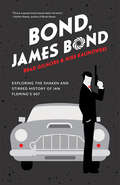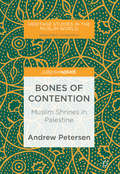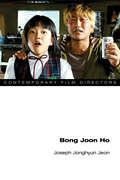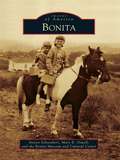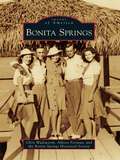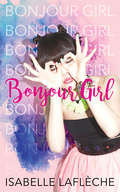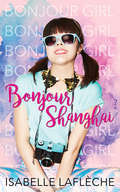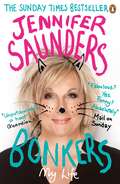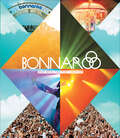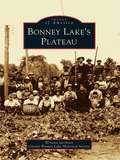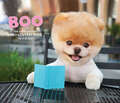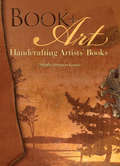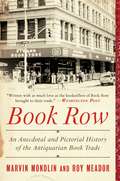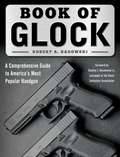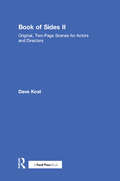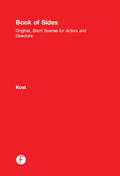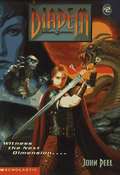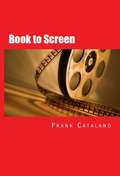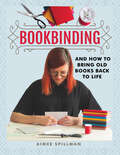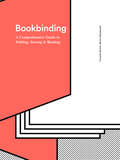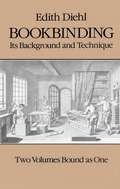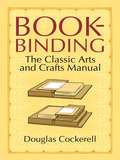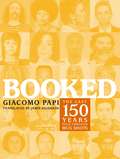- Table View
- List View
Bond, James Bond: Exploring the Shaken and Stirred History of Ian Fleming's 007
by Brad Gilmore Mike KalinowskiBreaking Down Six Decades of James Bond Movies#1 New Release in Action & Adventure Movies & Video, and Movie ReferenceHosts Mike Kalinowski and Brad Gilmore team up in this comprehensive examination of the longest running film series in the history of cinema. In Bond, James Bond, they explore the cinematic history of the James Bond collection to celebrate everything it got right and reflect on everything it got wrong.The complete cinematic biographies of James Bond. Since his initial portrayal by Sean Connery, James Bond has become a timeless icon worldwide. Now, comes the first-ever era-by-era breakdown of the much loved international spy—on and off the silver screen. Following the men who portrayed James Bond—Daniel Craig, Pierce Brosnan, Timothy Dalton, Roger Moore, and Sean Connery—readers will discover the characteristics that made him resonate, as well as the less glamorous relics that made him evolve.For fans of the Ian Fleming James Bond novels and movies. Cinephiles and fans can finally unscramble some of the best action movies of all time. Covering everything from cars to court cases, Bond, James Bond looks at the evolution of the 007 movies from all angles.Featuring bonus chapters on Bond women and musical scores, inside, you’ll also find:The origins of 007 in the early James Bond booksOff-screen politics, drama, and movements that shifted the series trajectoryThe “other” James Bond, comic books, and animated seriesIf you’re looking for Father’s Day gifts, gifts for men, or James Bond gifts—and enjoyed books like Some Kind of Hero, Nobody Does it Better, or Shaken—then you’ll love Bond, James Bond.
Bones of Contention: Muslim Shrines in Palestine (Heritage Studies in the Muslim World)
by Andrew PetersenThis pivot sets Muslim shrines within the wider context of Heritage Studies in the Muslim world and considers their role in the articulation of sacred landscapes, their function as sites of cultural memory and their links to different religious traditions. Reviewing the historiography of Muslim shrines paying attention to the different ways these places have been studied, through anthropology, archaeology, history, and religious studies, the text discusses the historical and archaeological evidence for the development of shrines in the region from pre-Islamic times up to the present day. It also assesses the significance of Muslim shrines in the modern Middle East, focusing on the diverse range of opinions and treatments from veneration to destruction, and argues that shrines have a unique social function as a means of direct contact with the past in a region where changing political configurations have often distorted conventional historical narratives.
Bong Joon Ho (Contemporary Film Directors)
by Joseph Jonghyun JeonSuccessful cult films like The Host and Snowpiercer proved to be harbingers for Bong Joon Ho’s enormous breakthrough success with Parasite. Joseph Jonghyun Jeon provides a consideration of the director’s entire career and the themes, ambitions, techniques, and preoccupations that infuse his works. As Jeon shows, Bong’s sense of spatial and temporal dislocations creates a hall of mirrors that challenges us to answer the parallel questions Where are we? and When are we?. Jeon also traces Bong’s oeuvre from its early focus on Korea’s US-fueled modernization to examining the entanglements of globalization in Mother and his subsequent films. A complete filmography and in-depth interview with the director round out the book. Insightful and engaging, Bong Joon Ho offers an up-to-date analysis of the genre-bending international director.
Bonita (Images of America)
by Bonita Museum and Cultural Center Mary E. Oswell Steven SchoenherrThe small rural community of Bonita is nestled in the fertile valley of the Sweetwater River. For over a century, families from nearby San Diego and Chula Vista have built secluded homes on large lots carved from the pioneer ranches that emerged in the 1870s on Rancho de la Nacion. Ulysses S. Grant Jr. and the Marstons and Allens built homes designed by architects such as Irving Gill and William S. Hebbard. They relished the rural equestrian lifestyle of their valley, and resisted the modernization that began after World War II with highways, shopping centers, and subdivisions.
Bonita Springs
by Allison Fortuna Chris Wadsworth Bonita Springs Historical SocietyThe pioneer history of Bonita Springs stretches back to the 1880s, when an Alabama cotton planter named B. B. Comer bought 6,000 acres of land along Surveyors Creek. He started a tropical fruit plantation, and his tiny village became known as Survey, in honor of the U.S. Army engineers who had first surveyed the region during the Seminole Wars decades before. When Florida started to boom in the early 20th century, investors bought up much of the land in the area. They quickly gave the community the more attractive moniker Bonita Springs and renamed the nearby creek the Imperial River. Beautiful beaches and world-class hunting and fishing soon turned Bonita Springs into a tourist mecca. Popular roadside attractions sprang up along the fast-growing Tamiami Trail, including the Everglades Wonder Gardens, the original Shell Factory, and the famous Naples-Fort Myers Greyhound Track.
Bonjour Girl (Bonjour Girl #1)
by Isabelle LaflècheDating, fashion, and drama: Clementine never has a dull day at the Parsons School of Design. <p><p> When Clementine Liu arrives in New York City to study at the Parsons School of Design, she knows that she’s found her place. It isn’t long before she meets her fashionista soulmate, the loud and charismatic Jake, and Jonathan, a dreamy fashion photographer who turns her world upside down. <p> Between schoolwork and glitzy fashion shows, Clementine launches a blog, Bonjour Girl, and her wit, originality, and flair quickly catapult the site to cult status. Unfortunately, this comes with a price: Clementine is faced with online abuse and public humiliation. In the midst of all the drama, she finds out that a classmate is not what she seems, and Clementine has to find a way to save both her reputation and Jake’s fashion collection.
Bonjour Shanghai: Bonjour Girl (Bonjour Girl #2)
by Isabelle LaflècheClementine Liu is back for more fashion, dating, and drama! <p><p>Clementine Liu, the super-stylish fashion student behind the Bonjour Girl blog, is about to finish her first eventful year in New York City. Ready to put all the drama behind her, she’s about to embark on a prestigious exchange program — in Shanghai! <p><p>Before Clementine actually sets foot in China, though, a whole bunch of problems put her impending departure in jeopardy. Despite it all, Clementine flies off to Shanghai, where she immerses herself in the new, exciting fashion world and cutthroat blogging scene. There’s also Henry, a charming classmate who’s on a mission to capture her heart, despite her New York boyfriend. <p><p>Even halfway across the world, Clementine can’t escape her problems. But can she find a way to survive and thrive while staying true to herself?
Bonkers: My Life in Laughs
by Jennifer SaundersTHE HILARIOUS, TOUCHING LIFE STORY OF THE ICONIC COMEDIAN AND NATIONAL TREASURE 'Fabulous? Yes. Funny? Absolutely' Mail on SundayJennifer Saunders' comic creations have brought joy to millions. From Comic Strip to Comic Relief, from Bolly-swilling Edina in Ab Fab to her takes on Madonna or Mamma Mia, her characters are household names. But it's Jennifer herself who has a place in all our hearts. This is her funny, moving and frankly bonkers memoir, filled with laughter, friends and occasional heartache - but never misery. BONKERS is full of riotous adventures: accidentally enrolling on a teacher training course with a young Dawn French, bluffing her way to each BBC series, shooting Lulu, trading wild faxes with Joanna Lumley, touring India with Ruby Wax and Goldie Hawn. Prepare to chuckle, whoop, and go BONKERS.'Beautifully written and frequently hilarious' Guardian'Her account of battling breast cancer is as honest as it is uplifting' Daily Mail'Endearing and hilarious. If only all celebrity biographies were this funny' Telegraph
Bonnaroo: What, Which, This, That, The Other
by Holly George-Warren“How do you get 80,000 fans to spend four days camping in the Tennessee sun? By offering the kind of moments this coffee-table photo book captures.” —Rolling StoneSet on 700 acres of rolling farm hills in Manchester, Tennessee, Bonnaroo is a four-day music and camping festival that draws in over 80,000 fans every summer. Featuring over 120 musical performances, along with comedy, cinema, sustainability workshops, and more, the grounds are converted into a virtual city of music and art. With over 200 photographs of some of the most legendary musical acts of all time, and numerous personal contributions by musicians and patrons, Bonnaroo: What, Which, This, That, The Other celebrates 10 years of this beloved music festival and the impact it has made on American culture. Whether fans of the Dave Matthews Band, Eminem, Radiohead, or Metallica, all music lovers unite to experience the magic of Bonnaroo.
Bonney Lake's Plateau
by Greater Bonney Lake Historical Society Winona JacobsenThe story of Bonney Lake and the plateau is not about towns and their storefronts, but of the enduring people who settled there before and after Washington achieved statehood. In spite of their brief presence, Michael Connell and Reuben Finnell are names credited for many of the area's key landmarks. In 1864, pioneer William B. Kelley arrived at the plateau. His public service as a territorial legislator and county auditor made him one of the most respected individuals of eastern Pierce County. Other pioneers, such as the Moriarty and Vandermark families, engaged in logging and farming on the plateau, which continued to be considered a wilderness. Oscar "Doc" Bowen, one of the settlers who arrived from the 1930s dustbowl, had a spiritual impact when he called for construction of the area's first church. Less than two decades later, Kenneth Simmons saw potential for further growth and pressed to incorporate the plateau's west end--forming the town of Bonney Lake.
Bonnie Sherr Klein's 'Not a Love Story'
by Rebecca SullivanBonnie Sherr Klein's "Not a Love Story" provocatively examines the first Canadian film to explore pornography's role in society from a feminist perspective. Directed by Bonnie Sherr Klein for Studio D, the National Film Board's women's unit, the film featured both Klein and Lindalee Tracey, an activist, performance artist, and stripper, as they toured the seamier fringes of pornography and sex work in Montreal, Toronto, New York, and San Francisco. Censored in Ontario upon its release in 1981, Not a Love Story collided with the escalating "Porn Wars" that contributed to the tearing apart of the second-wave feminist movement.Using interviews with members of the crew and extensive archival research into the production process, Rebecca Sullivan delves into the creation and reception of Not a Love Story to explore the issues of censorship, sexual labour and performance, and documentary practice that the film raised. An insightful analysis not just of the film itself but of the issues which surround feminist analyses of pornography as a genre, Bonnie Sherr Klein's "Not a Love Story" offers a fresh assessment of Canada's women's movement and the politics of feminist filmmaking during a volatile era.
Boo: The Life of the World's Cutest Dog
by J. H. LeeThe internationally bestselling book featuring the stuffed-animal cuteness of social media’s favorite Pomeranian, one of the first-ever viral sensations.Everyone loved Boo! His signature fluffy head and teddy bear like persona were irresistibly adorable. With millions of Facebook fans, Boo became an international superstar. This charming book features exclusive photographs of Boo doing all his favorite things: lounging around, playing with friends, exploring the whole wide world, and making those famous puppy-dog eyes. To know Boo was to love him, and this book is for anyone who loved the cutest dog ever.
Boogie Boogie, Y'all
by C. G. EsperanzaAuthor-illustrator C. G. Esperanza delivers a celebratory ode to graffiti and the Boogie Down Bronx through an infectious read-aloud beat and colorful illustrations that leap right off the page! Perfect for fans of Crown: An Ode to the Fresh Cut and Keith Haring.An NPR Best Book of the Year, ALSC Notable Children's Book of the Year, Odyssey Award winner, Pura Belpré Honor Award winner, New York City Book Award winner, and Audie Award finalist!The city is alive with vibrant art in every corner of the parks, the shops, the trains. But most people are too busy to see it—or worse, choose to ignore it! When three children stop to marvel at the art around their community, they realize it’s up to them to show everyone else how truly special it is when art and reality dance together so seamlessly.Boogie boogie, y’all.The city boogied all day.Busy, busy, busy,Till one kid stopped to say,Woah, woah, woah!Look at the art on the wall!
Book + Art: Handcrafting Artists' Books
by Dorothy Simpson KrauseDiscover what happens when you add artmaking and bookbinding together. With Book + Art, explore the basics of surfaces, images and words in order to create provocative works of art with layers of meaning. Whether you're altering a pre-made book or creating your own, here you'll find both the instruction and the inspiration to get it done. In addition to learning mixed-media techniques-such as how to age paper, transfer images and make your own monoprints-you'll be given step-by-step instruction for numerous book structures including: Single-fold and bi-fold books Simple and extended accordions Perfect bindings Side-sewn books Single- and multiple-signature books Boxes Unbound collections Add the art of the book and the book as art to your own artmaking repertoire today and start making your own meaningful artists' books. Foreword by Judith A. Hoffberg, Editor and Publisher of Umbrella.
Book Row: An Anecdotal and Pictorial History of the Antiquarian Book Trade
by Marvin Mondlin Roy MeadorThe American Story of the Bookstores on Fourth Avenue from the 1890s to the 1960s New York City has eight million stories, and this one unfolds just south of Fourteenth Street in Manhattan, on the seven blocks of Fourth Avenue bracketed by Union Square and Astor Place. There, for nearly eight decades from the 1890s to the 1960s, thrived the New York Booksellers’ Row, or Book Row. This richly anecdotal memoir features historical photographs and the rags-to-riches tale of the Strand, which began its life as a book stall on Eighth Street and today houses 2.5 million volumes (or sixteen miles of books) in twelve miles of space. It’s a story cast with characters as legendary and colorful as the horse-betting, poker-playing, go-getter of a book dealer George D. Smith; the irascible Russian-born book hunter Peter Stammer; the visionary Theodore C. Schulte; Lou Cohen, founder of the still-surviving Argosy Book Store; and gentleman bookseller George Rubinowitz and his formidably shrewd wife, Jenny.Book Row remembers places that all lovers of books should never forget, like Biblo & Tamen, the shop that defied book-banning laws; the Green Book Shop, favored by John Dickson Carr; Ellenor Lowenstein’s world-renowned gastronomical Corner Book Shop (which was not on a corner); and the Abbey Bookshop, the last of the Fourth Avenue bookstores to close its doors. Rising rents, street crime, urban redevelopment, and television are many of the reasons for the demise of Book Row, but in this volume, based on interviews with dozens of the people who bought, sold, collected, and breathed in its rare, bibliodiferous air, it lives again.
Book of Glock: A Comprehensive Guide to America's Most Popular Handgun
by Robert A. Sadowski Stanley J. RuselowskiWhile movies and television have made many people familiar with the name Glock, not many know the history of Glock’s pistols. With The Book of Glock, Robert A. Sadowski showcases all of Glock’s American handgun models, from the first model, the Glock 17, which premiered in 1982, to the all-new G43, and educates firearms enthusiasts on the quirks of each. The Book of Glock references all Glock pistols available in the United States with in-depth information on all models—history, serial numbers, rare Glock variants, comparative models, cutaway sales models, and more. Sadowski worked closely with Stanley Ruselowski, the president of the Glock Collectors Association, to bring readers information and photos of rarely seen Glocks. Each chapter is dedicated to a different model. Sadowski provides a timeline of the company’s evolution and a close look at how Glock redefined the combat pistol. Other chapters touch on rare models, commemorative editions, and Glock tools and accessories. Whether a firearms collector or a new enthusiast, anyone can enjoy Sadowski’s analysis of Glocks throughout history.
Book of Sides II: Original, Two-Page Scenes for Actors and Directors
by Dave KostBook of Sides II: Original, Two-Page Scenes for Actors and Directors is the second book in the Book of Sides series by Dave Kost, featuring original, two-page, two-character scenes for use in acting, directing, and auditioning classes. While shorter than the traditional three-to-six-page scenes commonly used in classes, Book of Sides II features longer scenes than the first Book of Sides with greater character development, more reversals, and stronger climaxes. Balanced, structured scenes designed specifically for educational use challenge both actors and directors equally with objectives, obstacles, tactics, and subtext; Two-page length is ideal for high-intensity exercises and faster-paced workshops; Printed in easy-to-read film-script format with plenty of room for notes; Scenes are completely original and unencumbered by copyright, so students may film and post legally on the internet; Universally castable, so all roles can be played by actors of any gender, appearance, skill level, or ethnicity; Accessibly-written for modern students, helping them to focus on the fundamentals of performance and directing; Simple and conducive to performing in a classroom without sets, costumes, or special props. This book was written by an educator for educators and designed for use in the classroom. Never search for scenes again!
Book of Sides: Original, One-Page Scenes for Actors and Directors
by Dave KostLooking for fresh, original scenes for your fast-paced acting or directing class? Tired of the same old material everyone recognizes? Want the flexibility to play any character in any scene? Book of Sides: Original, Short Scenes for Actors and Directors offers scenes that are considerably shorter than those in similar books but still feature the structure of typical scenes with arcs, clear playable objectives, and stakes for both actors. Here you will find scenes that are: One-page in length and specially designed for new, high-intensity exercises that help students develop quickly Printed in an easily readable, film-script format that provides plenty of room for annotations Completely original, allowing you to produce and distribute reinterpretations without worrying about copyright restrictions Universally castable, with roles that can be assigned to actors regardless of gender, appearance, skill level, or race Simple and conducive to performing in the classroom without props, costumes, or sets Perfect for audition workshops and crowded directing or acting classes where everyone wants an opportunity to perform Written in accessible, contemporary language that keeps student actors engaged Don’t miss out! In Book of Sides, Dave Kost brings two decades of teaching experience to the table to deliver the ideal set of scenes for busy classroom settings, auditions, and general training.
Book of Signs (Diadem Series #2)
by John PeelDiadem chronicles the adventures of three teenagers from very different worlds. Score is a streetwise New Yorker, Renald lives in a Medieval world where she readies herself for battle, and Pixel is confined to a one-room world of Virtual Reality. But now they all exist in the Diadem, the circuit of all worlds where their awesome purpose unfolds.
Book to Screen (How to Adapt Your Novel to a Screenplay #5)
by Frank CatalanoADAPTING YOUR NOVEL INTO A SCREENPLAY BOOK TO SCREEN was first presented as part of the 25th Annual Writer's Conference sponsored by San Diego State University on February 6 through the 8th, 2009 at the Double Tree Hilton Hotel in Mission Hills, California. The following transcript was presented and recorded by Frank Catalano as part of the programs offered at the conference. The book is based partly upon that presentation, focuses on the adaptation of an existing novel into a screenplay for presentation as a motion picture, television program or Internet content. Writers of fiction and non-fiction and industry professionals from the publishing business primarily attended the 25th Annual Writer's Conference. Mr. Catalano's seminars focused upon those writers seeking to adapt their novels into screenplays. The complete list of seminar presentations by Frank Catalano for this conference is: BOOK 1: WRITE GREAT CHARACTERS IN THE FIRST TEN PAGES BOOK 2: WRITING ON YOUR FEET - IMPROVISATIONAL TECHNIQUES FOR WRITERS - Part 1 BOOK 3: START YOUR STORY AT THE END BOOK 4: THE FIRST TEN PAGES BOOK 5: BOOK TO SCREEN BOOK 6: ACTING IT OUT - IMPROVISATIONAL TECHNIQUES FOR WRITERS - Part 2 BOOK 7: WRITE GREAT DIALOGUE
Bookbinding and How to Bring Old Books Back to Life (Crafts Ser.)
by Aimee SpillmanRemedies the gap in the market for an easy to follow beginners book binding that's fun for the whole family!This book is a breath of fresh air showing you the fundamental skills and techniques you will need to start binding your own books. You don’t need a lot of expensive tools or materials to do bookbinding and this guide has been made to make the process accessible for any one who wants to do some “weekend projects”. This book will appeal to people who love books, but lead busy lives and yet still want to be creative. It will show you the basics and teach the fundamental skills and practices that will get you binding your own books in no time. These skills will then be transferable across a number of projects contained within and hopefully make you want to learn more. The ‘Weekend Projects’ will include how to do simple repairs on your old and well loved books, giving them a new lease of life, including adding hard covers to paperbacks and doing simple repairs. Along with these we will be creating bespoke notebooks and it will show you some unique ways to use your new found binding skills to keep and store your special cards. The aim of this book is to inspire new binders young to old and everything in between.
Bookbinding: A Comprehensive Guide To Folding, Sewing And Binding
by Franziska Morlok Miriam WaszelewskiThis comprehensive reference guide explores bookbinding techniques in start-to-finish detail, explaining all possible options in clear illustrations and easy-to-follow text, making it easy for artists and designers to compare and choose among them. From types of paper to folding methods, to all of the available paperback and hardcover bindings, to finishing techniques and case studies by contemporary designers, Bookbinding is truly the must-have book for professional designers and production staff. Bookbinding is also a work of art in its own right, given an award by the Type Director's Club for typographic excellence.
Bookbinding: Its Background and Technique
by Edith DiehlEdith Diehl (1876-1955) was one of the world's foremost practitioners of traditional bookbinding and an exceptionally able teacher. From the vantage point of a lifetime's experience, she gives today's bookbinders a historical survey of this centuries-old art and an eminently practical guide.Nearly one half of the encyclopedic volume is devoted to an overview of the historical development of bookbinding. The author shows how the codex form of the book became identified with the Christian era, how bookbinding became a craft and trade in the 15th century, and how the production and distribution of books shifted from the monasteries and universities to the illustrious printer-publishers of the 15th and 16th centuries. She describes various bookbinding practices such as sewing, the use of boards and leathers, hand versus machine binding, cased books, etc. And she examines in depth the different national styles of book decoration in Italy, France, England, Germany, North America, and other countries, and the specific contributions of such influential bookbinders as Jean Grolier, Thomas Mahieu, Le Gascon, Samuel Mearne, Roger Payne, Jacob Krause, Edmund Ranger, and John Ratcliff. Ninety-two full-page plates provide visualization of certain key points and, above all, numerous examples of the finest decorated bindings.Edith Diehl then guides the reader through more than 400 profusely illustrated pages on the craft of hand bookbinding. She details and illustrates the steps involved in the nearly 30 necessary binding operations: collating and paging, pulling and removing glue, guarding and mending, pressing, sewing, backing, lacing-in, headbanging, lining up back, casing texts in protective cover, covering, cutting inside margins and filling in, and many more. In addition she conveys much useful information on such ancillary topics as doublures, fly-leaves, half bindings, limp bindings, vellum bindings, slipcases, repairing old bindings, cleaning and washing papers, materials (leather, paper, gold leaf, glue, paste), finishing tools, tooling, lettering, etc. The 242 illustrations that accompany this book-within-a-book are unmatched for economy and clarity.
Bookbinding: The Classic Arts and Crafts Manual
by Noel Rooke Douglas CockerellOne of the principal texts of the Arts and Crafts movement in England, this classic work brought a resurgence of life and vigor to the ancient craft of binding books by hand. Its fame and usefulness has endured for more than a century, as evidenced by the many contemporary bookbinders and libraries who consider it to be the clearest and most valuable exposition of the technique of hand bookbinding in English.The text concisely covering virtually every aspect of the craft -- from folding and collating pages, trimming and gilding edges, and cutting and attaching boards to preparing covers, mitring corners, designing and inlaying on leather, pasting down end papers, and creating clasps and ties. More than 20 informative text diagrams and eight plates, as well as a glossary and an index complete this important manual.A "must-have" for craftspeople, libraries, and book preservationists, the volume remains one of the most valuable manuals available on the technique of hand binding.
Booked: The Last 150 Years Told through Mug Shots
by Jamie Richards Giacomo PapiEvery year twelve million Americans are arrested and photographed by the police. In many ways, mug shots are our history. Using a dazzling selection of mug shots that are arrestingly raw in their starkness and strangely eloquent in their simplicity, this absorbing, humorous, often bewildering collection sheds a whole new light on our rebellious century.From political icons Martin Luther King Jr.and Angela Davis, to A-list celebrities Hugh Grant and 50 Cent, from killer Ted Kaczynski to the actor who aided in Abraham Lincoln's assassination, from prisoners of Auschwitz to a bearded Saddam Hussein, all of them declare a simple truth: The last 150 years told through police photography is truly an alternative history. Author Giacomo Papi's brisk and insightful commentary enlightens us with intriguing backstories and little-known facts.A feast for the eyes and the mind, Booked presents an ingenious and utterly unique snapshot of our times.
